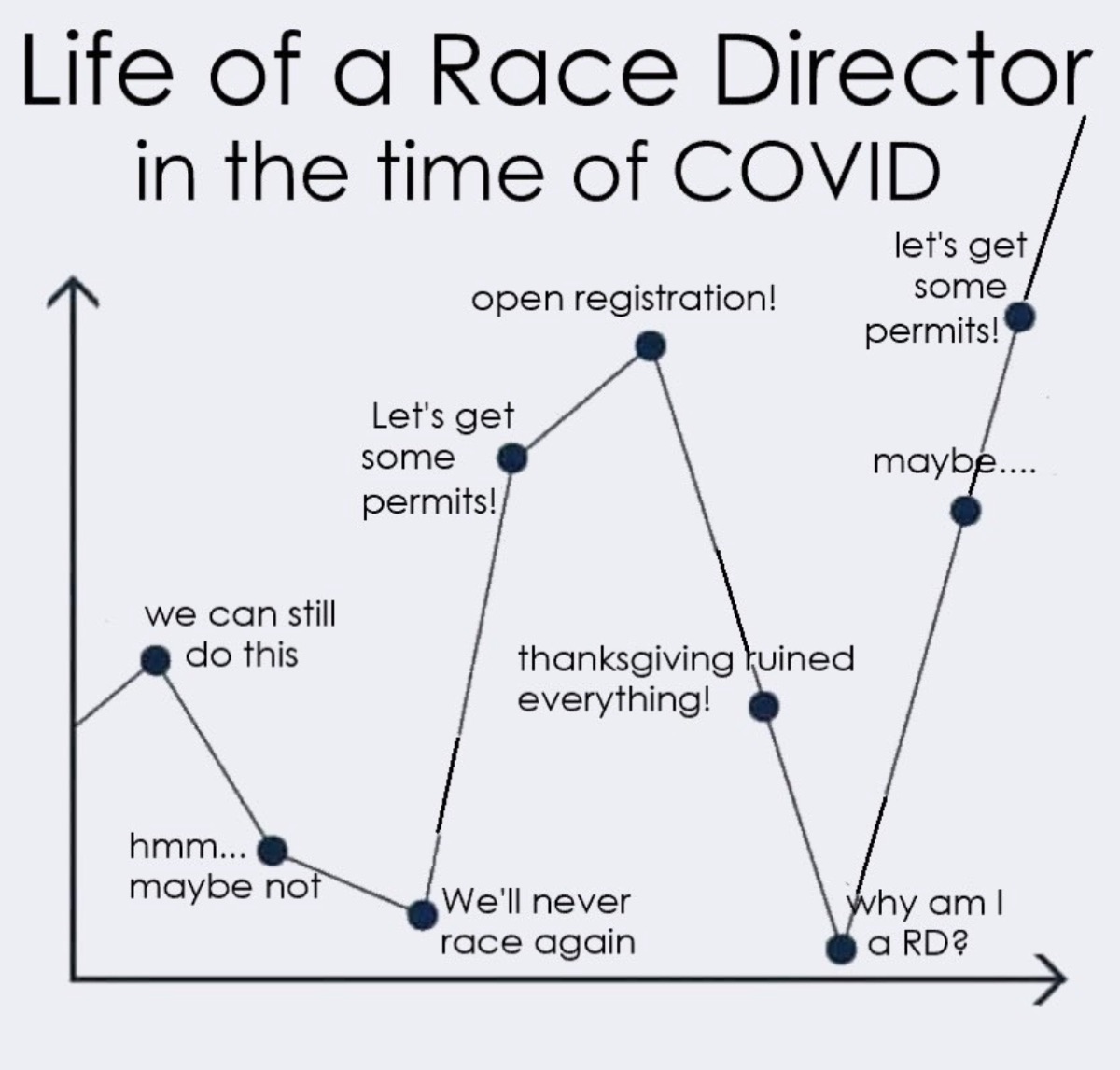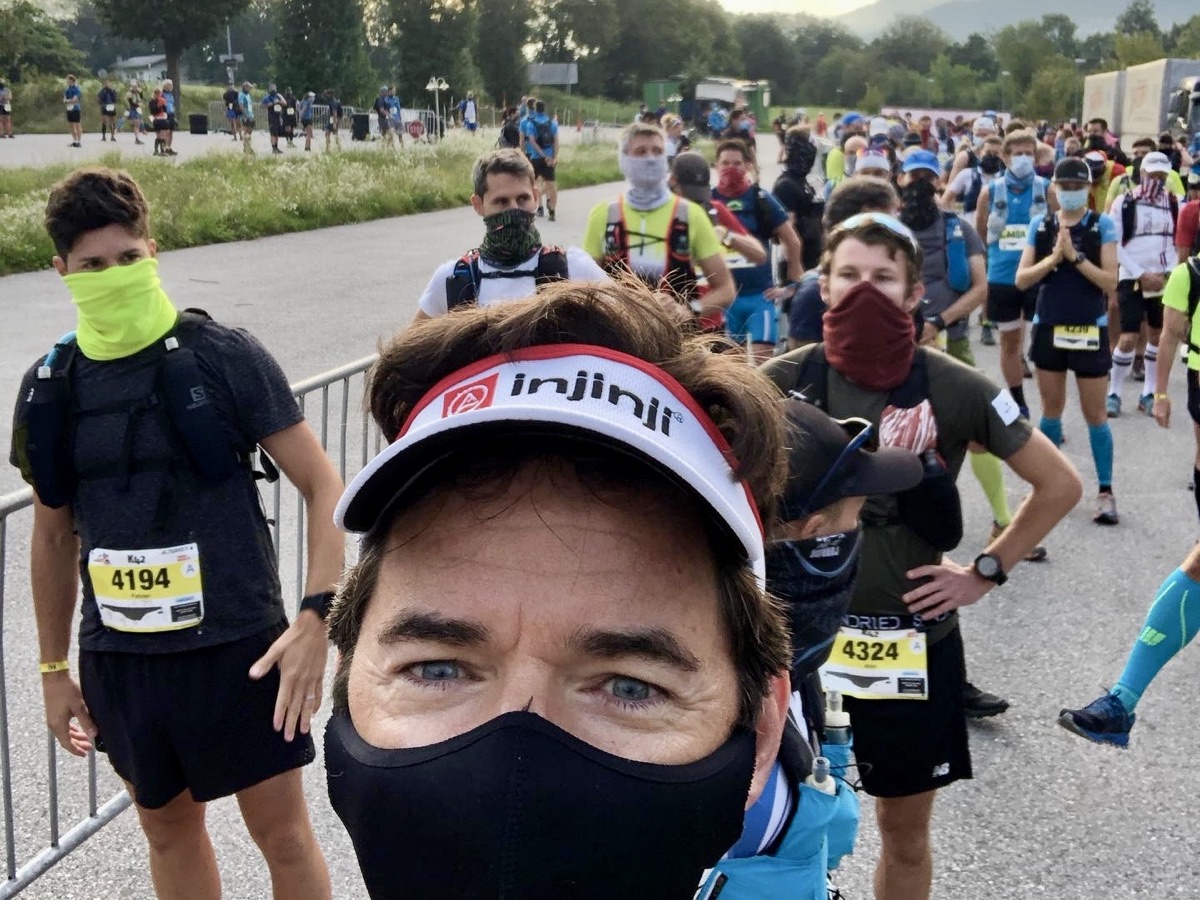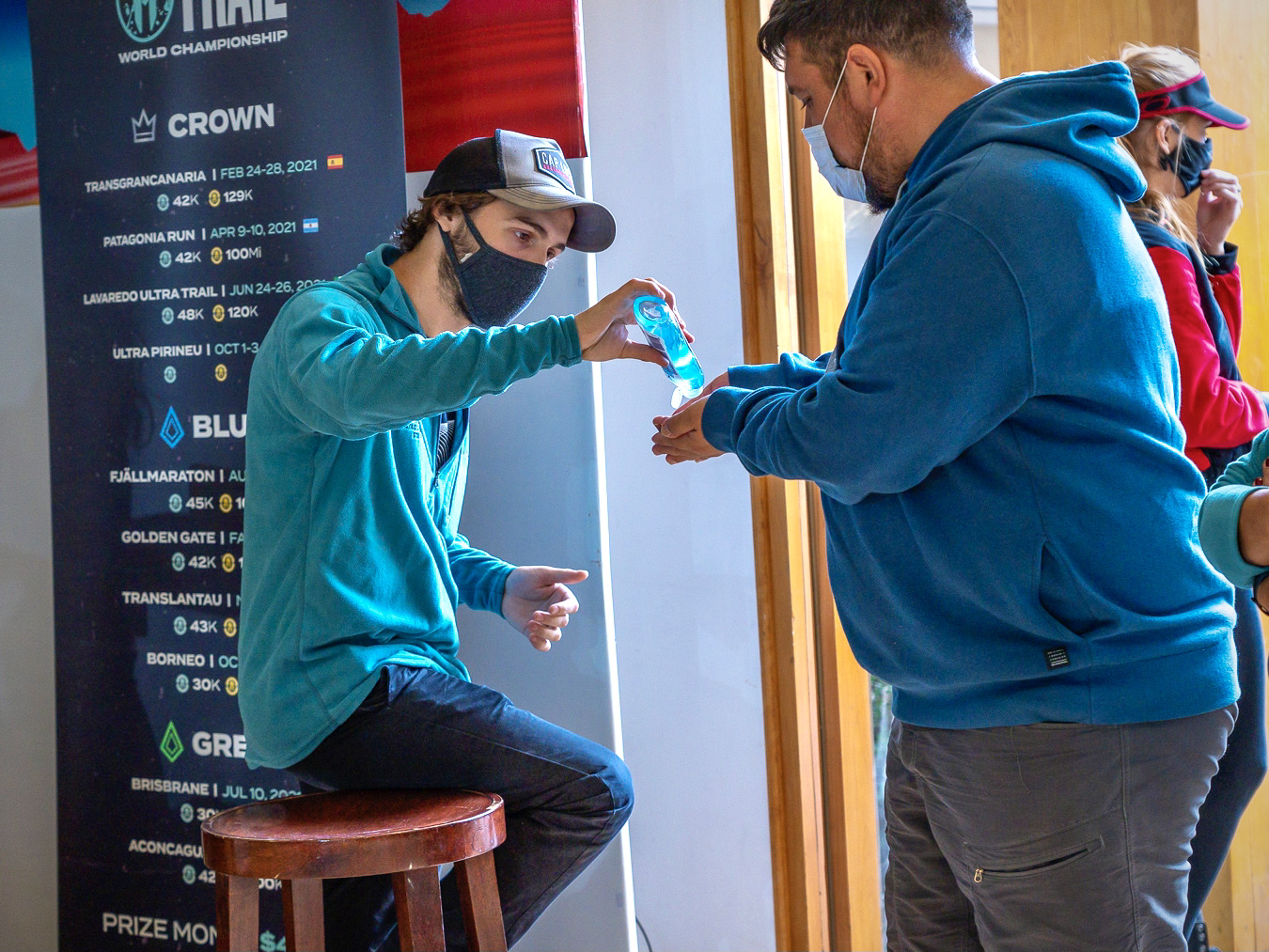What’s that smell? Is it?! Could it be? After a year of life and livelihood lockdowns due to COVID-19, many of us can feel optimism in the air. That’s because in an increasing number of locations around the world and with increasing frequency, running races are returning.
This fact might represent a welcoming sense of normalcy for some of us and be reason for unease in others. Both of these are completely rational responses. No matter where your feelings are, we thought it might be helpful to share what we know about the science of making racing and traveling to races safer.

A glimpse inside the “mind” of the Rainshadow Running race organization during the past year of the COVID-19 pandemic. Image: Instagram.com/p/CMQnwSFHzzd/
Does COVID-19 Spread Outdoors?
One of the many waves we’ve all ridden over the past year is figuring out what’s “right” and “wrong” when it comes to running in shared spaces outdoors. Do we mask? Do we walk, run, or bike six, 12, or 40 feet apart? Do we forever touch feet and elbows instead of high-fives and hugs?
The advice coming from authority figures has changed often. Although confusing at times, this is a very natural part of the evolving science of a novel virus moving through the global population. So what does the current literature say about outdoor COVID-19 transmission? And what does that mean for running and racing safely?
Despite the heavy breathing of us runners, outdoor transmission is considerably lower than indoor transmission. In studies looking at both general transmission and super-spreader events, less than 10% of reported transmission occurred in outdoor settings (2). Specifically, in a study out of Japan looking at both clusters and general transmission, researchers found that the odds of COVID-19 transmission were 18.7 times greater indoors compared to outdoor settings.
Although the specific determinants of outdoor transmission are still not fully understood, the cases appeared to be affected by the known risks of duration of exposure (15 minutes of close contact with someone who has COVID-19, for example), frequency of exposure, density of gatherings (multiple households too close together, as an example), whether masks were worn or worn properly, and periods of being inside during a predominantly outdoor event (weddings and overnight housing are two examples) (2).
But I thought we were spewing particles everywhere? We are, whether we’re outside or inside. We know that indoor COVID-19 transmission is higher because factors like poor ventilation, low humidity, air conditioning, and low ultraviolet light allow viral particles to survive longer in that environment. When we’re outside running, not only do we need to create particulate projectiles with enough force that they make their way to another runner, but they also need to survive the environment on their way. And from there, the viral particles need to get past our innate immune-system structures, like our skin, nose hairs, mucus lining, and more. We can start to see why the outdoor transmission of the COVID-19 virus occurs with less frequency.
While we know that the risk of outdoor transmission is really low, it’s not impossible. Science tells us there are three fundamental ways to limit risk in outdoor environments:
- Maintain low density events. In running races, this means things like wave starts, limiting runners’ time and capacity at packet pick-up, preventing aid-station overlap of many runners at one time, and creating finish-line environments where everyone can spread out.
- Wear masks when social distancing can’t be maintained and when inside. We know that masking is effective for limiting transmission between individuals, so using masks in places at races where effective social distancing is hard to maintain should help.
- Stay outside. This means avoiding inside moments at races, such as shuttles and carpooling with multiple households, bathrooms, finish-line buildings, and housing with multiple households on overnight trips.
How to Limit COVID-19 Risk While Racing
Every race organization’s approach to hosting a race during the past year has been different, in large part because regulations among cities, regions, various public lands, and countries have differed wildly. Although not every event has had a great COVID-19 protocol in place, some have really stepped up to create races that are as safe as possible. It’s those events that will act as examples for many other races that will go off in 2021.
Here are some of the science-based protocols we’ve seen used at races so far:
- Asking racers to follow their appropriate government agencies’ regulations and recommendations for travel;
- Asking for participation from local racers only to limit travel and overnight stays for nonessential, recreation purposes;
- Limiting the number of crew that runners can have, limiting or eliminating pacers, and decreasing crew-access points to reduce congestion;
- Asking racers to not attend if they’ve been sick or have been exposed to someone who’s been sick within two weeks of the event;
- Utilizing temperature controls pre-race (which can help catch symptomatic cases, but will miss the asymptomatic ones);
- Requiring everyone to maintain social distance and wear masks at the start, finish, aid stations, and anytime social distance cannot be maintained both inside and outside;
- Creating wave starts;
- Creating modified aid stations that limit touch points and offer sanitization at them;
- Requiring organization members and volunteers to wear personal protective equipment; and
- Disinfecting all touch-based surfaces frequently (4).

Social distancing, masks, and a small group at the 2020 Innsbruck Trail Marathon. Photo: Scott Dunlap
How to Travel to Races Safely During COVID-19
Here comes my science soapbox: Racing doesn’t happen in a bubble. Racing can most definitely happen safely given what we know about the outdoor transmission of COVID-19 and some minimal guidelines many race organizations are already utilizing successfully in the past year.
But participation in any race involves more than just the race, and that’s where the transmission of COVID-19 is at an increased risk of happening. There’s the fact that some races and surrounding communities have variable COVID-19 protocols, the travel required to get to races, as well as what you do for lodging, food, and entertainment once you’re there.
Let’s walk through what minimizing your COVID-19 risk while traveling to and from races looks like:
Choosing a Race
Some of us live in places with limited access to races right now, while others of us have plenty of choices among races happening in our regions and countries. Consider participating in events with robust COVID-19 protocols that alighn with the science of COVID-19 transmission. This likely means you are looking at races that are openly altering their race-day experience for the time being (by doing the things described in the previous section). Your choice will help protect not only you but all participants as well as the local community in which the race occurs.
Local Versus Destination Race?
There is definitely less risk involved in racing locally when it comes to bubble-bursting touch points and non-socially-distant exposure to other households than in traveling across state or country borders. This is largely due to housing and travel logistics.
If you are traveling outside of your bubble and are unvaccinated, you should get tested for COVID-19 one to three days before traveling and three to five days after your return. If traveling after being fully vaccinated, you do not need to get tested pre-travel but should get tested three to five days after your return. Additionally, follow all regulations and recommendations for your origin, destination, and the places through which you travel.
Drive or Fly?
Well, airplanes are called ‘germ tubes’ for a reason right? All joking aside, this is a consideration for each of us. Driving takes time and flexibility, whereas flying might be more convenient or the only option to get to some races. However, driving gives you less cross-household touch points and exposure than utilizing public transit, traveling through airports, and via airplanes.
Accommodations
This might mean opting to rent your own place to stay instead of crashing with friends locally and sharing accommodations with other runners. This is going to come down more and more to vaccinated individuals/households and how many other households you mix. It is low risk for vaccinated individuals from two households to share accommodations, but risk rises when more households or unvaccinated individuals mix in. Pre-travel testing and using care to minimize exposure risk on a day-to-day basis before staying together might eliminate some of that risk.
Key Takeaways for Running Races Safely During COVID-19
As various areas around the world reintroduce racing with more frequency, here are the key takeaways for safer traveling and racing during COVID-19:
- Stay informed and flexible. The broadest advice is to keep doing our best with the current best information we have. This includes utilizing resources like the Centers for Disease Control and Prevention (CDC) in the U.S. or your country’s national public-health agency, the World Health Organization (WHO), as well as your state and local government to help steer your actions. All of this is likely to remain a moving target for a while, as vaccines become more available, localized outbreaks come and go, and our understanding of COVID-19 changes.
- Get vaccinated. Being vaccinated means the virus has one less body to replicate and potentially create a new variant in. It also means you are less likely to become infected with and severely sick from COVID-19. Maybe most important for those wanting to travel and race, it’s looking more and more like being fully vaccinated means that you are much less likely to have an asymptomatic infection and a decreased ability to transmit COVID-19 to others (8). This makes traveling to a place outside of your community and returning to your community afterward much less risky.
- Follow your domestic and international travel restrictions and recommendations when you travel (6, 7). Again these will continue to change frequently, and may include destinations to avoid, quarantines, and COVID-19 tests pre- and post-travel.
- Don’t travel if you’ve been sick with COVID-19 symptoms in the last two weeks or if you’ve been in contact with someone who has in the last two weeks (5).
- Wear a mask that covers your nose and mouth when in public. This includes planes and other forms of public transit (including ride shares!) and when you cannot maintain social distance from people outside your household.
- Practice good hand hygiene. Do we need a reminder of which songs are long enough for proper hand washing with warm water and soap? Additionally, use hand sanitizer with at least 60% alcohol when you can’t wash your hands.
- Consider accommodations. Consider personal housing or encouraging all parties to be vaccinated or have a COVID-19 test before merging households.
- Chose races and locations wisely. Looking at races with concrete COVID-19 protocols and looking at regional rates of infection/positivity and resources for mitigation at your potential destination may sway you to do a race you’ve never considered or avoid a bucket-list event for the time being.
- Reduce or eliminate your crew and pacers. By reducing the number of friends and family you bring to an event, you’ll limit potential transmission vectors at the event and during travel to and from it.
- Listen to your gut. Even if your local and national governments allow for races and traveling involved in doing them, your body and mind will tell you when it’s right for you to race again.
References
- Dominski, F. H., & Brandt, R. (2020). Correction to: Do the benefits of exercise in indoor and outdoor environments during the COVID‑19 PANDEMIC outweigh the risks of Infection?Sport Sciences for Health, 17(1), 267-267. doi:10.1007/s11332-020-00686-8
- Bulfone, T. C., Malekinejad, M., Rutherford, G. W., & Razani, N. (2020). Outdoor transmission of sars-cov-2 and other respiratory viruses: A systematic review.The Journal of Infectious Diseases, 223(4), 550-561. doi:10.1093/infdis/jiaa742
- Nishiura H, Oshitani H, Kobayashi T, et al. Closed environments facilitate secondary transmission of coronavirus disease 2019 (COVID-19). medRxiv doi; 1101/2020.02.28.20029272, 16 April 2020
- Safer travel ideas. (2021, April 02). Retrieved April 07, 2021, from https://www.cdc.gov/coronavirus/2019-ncov/travelers/travel-risk.html
- When not to travel: Avoid spreading covid-19. (2021, April 02). Retrieved April 07, 2021, from https://www.cdc.gov/coronavirus/2019-ncov/travelers/when-to-delay-travel.html
- Domestic travel During COVID-19. (2021, April 02). Retrieved April 07, 2021, from https://www.cdc.gov/coronavirus/2019-ncov/travelers/travel-during-covid19.html
- International travel During COVID-19. (2021, April 02). Retrieved April 07, 2021, from https://www.cdc.gov/coronavirus/2019-ncov/travelers/international-travel-during-covid19.html
- Science brief: Background rationale and evidence for public health recommendations for fully vaccinated people. (2021, April 02). Retrieved April 09, 2021, from https://www.cdc.gov/coronavirus/2019-ncov/science/science-briefs/fully-vaccinated-people.html


